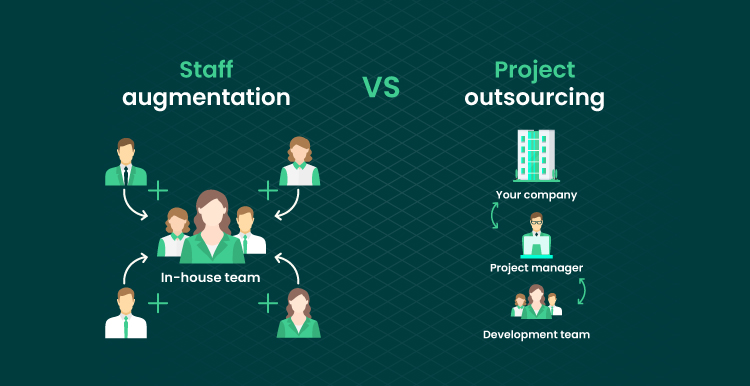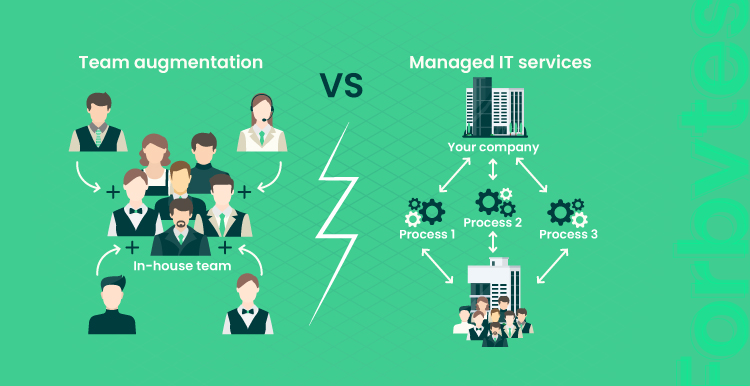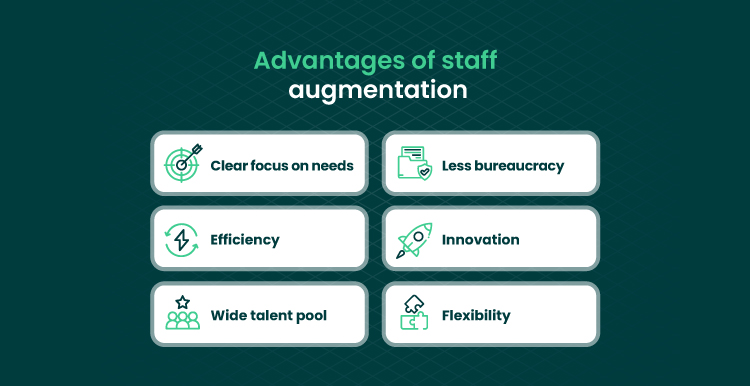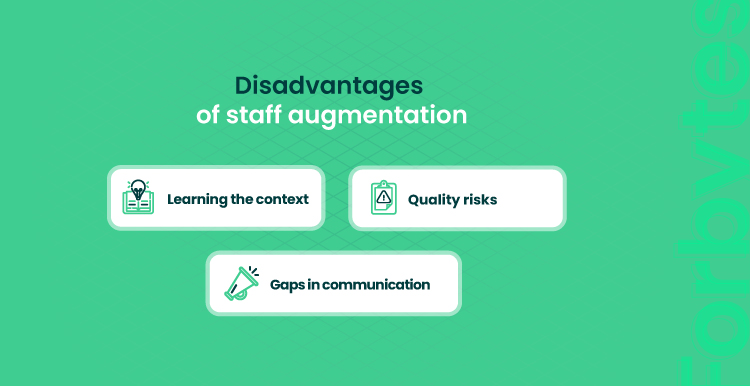In 2024, the global IT outsourcing market is projected to reach an impressive $541.10 billion, and by 2029, it is expected to grow to $812.70 billion. This steady growth underscores the increasing reliance on outsourcing for various IT functions.
In 2023, the IT outsourcing market value was $512.5 billion, with significant expansion driven by segments like app outsourcing. US-based companies play a pivotal role, generating 36% of the total outsourcing industry revenue, reflecting their strong demand for cost-effective and specialized IT services.
These trends highlight why outsourcing remains an attractive strategy, particularly for US businesses. By using outsourcing, companies gain access to specialized skills, reduce operational costs, and increase efficiency by making it a go-to option for staying competitive in a rapidly evolving market.
One model that has gained traction in this growing landscape is staff augmentation. This approach provides businesses with a flexible way to scale their teams, filling skill gaps and meeting project demands without the long-term commitment of traditional hiring.
In this article, we’ll explore staff augmentation services as an effective cooperation model, clarify its distinction from other IT outsourcing terms, and discuss its advantages and disadvantages to help you determine if it’s the right fit for your business. Let’s dive in!
What Is Staff Augmentation?
Staff augmentation is a model that allows business leaders to complement their teams with professionals hired from a third-party vendor. There’s a difference between team augmentation and traditional hiring. In the first case, you hire experts who already work for a particular company. This company specializes in IT outsourcing and provides clients with staff augmentation services on a contractual basis.
You may be interested in why the staff augmentation exists at all. It’s much easier to hire people straight into your local team without any mediators, isn’t it? But this is not as easy as it seems. Let’s explain the meaning of staff augmentation step-by-step.
Suppose that you plan to launch a project but have a limited budget. Your task is to get the most out of the resources you have. If your business is based in the countries like UK, USA or Norway, then building a product will cost you a lot. But today’s technologies give you a solution to this challenge. You can consider outsourcing or outstaffing for your business purposes. By the way, the difference between outsourcing and outstaffing is well explained in our recent article.
In brief, outsourcing is when you pay for the project to be built for you. Your outsourcing vendor manages the project and delivers results. Outstaffing, which means the same as staff augmentation, is when you pay for the skills of the professionals who join your existing team. The project, in its turn, is executed and managed by you in this case. As we assume that you already have a team that works on your project, obviously, you decide to try outstaffing.
Let’s move on. Suppose that you chose the country to outstaff from and decided upon the number of people needed. You outlined the relevant skillset and discussed the terms of cooperation with a vendor. And a moment before signing a contract, the following thought came to your mind, “Oh, gosh… Why didn’t I hire these experts outside the outsourcing company? It would be much cheaper.”
And here it is: you are now determined to leave outstaffing behind, save money, and find experts somewhere else. But wait… You need to answer these questions first:
- Where should I look for reliable interview candidates?
- How to know that they are good at the needed skills if I have no technical expertise?
- What form of quality and performance assurance do I get if I hire them?
This may be the exact moment when outstaffing will come to your mind for the second time. Why so? Because when choosing staff augmentation (or outstaffing), you:
- Get quality assurance. Your staff augmentation partner bears responsibility for the high quality of the services provided. By hiring developers from an outstaffing company, you are sure that you get reliable and quality results.
- Pay only for the skills you need. People joining your team are selected based on the list of your requirements. You outline the soft and hard skills that you are looking for and pay for the work of those who fully fit your description.
- Get rid of organizational hustle. Everything is put on the outstaffing company’s shoulders. By everything, we mean taxes, HR management, recruiting, administrative duties, etc. The task on your side is to ensure a smooth integration of newbies into your internal team. Also, you should communicate their responsibilities clearly.
- Choose whom to hire. You can either ask the staff augmentation firm to hire people by specifying the needed skills or take part in the interviewing process yourself. Flexibility is a great bonus to outstaffing.
- Get relevant tips and the ongoing support of a partner. Your team is complemented by experts with vast experience in software development. They can bring a lot of new staff to your project, from innovative skills and knowledge to overall work tips and collaboration hacks.
Staff Augmentation vs Managed Services
This part of the article is devoted to clarifying the difference between confusing IT terms. We will start with the difference between staff augmentation and managed services.
Staff augmentation allows clients to hire professionals and manage their work by themselves. That is, a client has to organize their work process at the same pace as their team adopts. Staff augmentation vendors take care of all organizational and administrative processes. Meantime, a customer is focused on managing direct project-based tasks.
Under the staff augmentation, you need to keep track of the project’s progress by yourself. The quality of collaboration between newbies and the in-house development team also depends on how well the processes are organized.
Managed services are somewhat different. Your partner takes care not only of the administrative and organizational tasks but also of the management of the entire project. That is, the company frees you from the duty to manage the work process by yourself. The responsibility for the experts’ work on your project is put on a third-party project manager.
This method of cooperation is applied in cases when you lack tech expertise to evaluate the results of work. And when you need third-party professionals to manage everything for you. Usually, businesses that decide to choose this model don’t want to be involved in work on a daily basis. They prefer paying for management and devoting their time to strategic and broad tasks.
Despite the difference, staff augmentation and managed services have much in common. In both cases, you entrust the work on a project to third-party professionals. The difference lies in the degree of responsibility imposed on your partner. Staff augmentation gives you more flexibility and independence. Managed services, in turn, save you time and enable you to focus on a broader growth perspective.
Staff Augmentation Services vs Consulting Services
These two models are different in many aspects. The common thing between them is that both are used for facilitating software development and building the right product strategy. But staff augmentation and project-based consulting services differ in the following:
- Time aspect. Staff augmentation presupposes long-lasting cooperation between a remote development team and a client. Project-based consulting is limited in time. Actually, this is a one-time investment aimed to help clients build a better plan or strategy for their project.
- The type of services. Staff augmentation is chosen to supplement the team with experts possessing the necessary skills. Consulting services are implemented in cases when this is not people’s work that you need but their expert views on your project.
- Managerial aspect. Under the staff augmentation, you manage the work process directly. What you get are the means to achieve the results you aim at. And these means are human skills. In consulting, you do not manage the work of experts; your task is to voice a problem and get guidance, plan, analysis, research, test results, etc in the end.
- The result of cooperation. Staff augmentation results in better outcomes on your project. You get better quality, speed, performance, consistency, or all of this. That is, you see immediate results from hiring professionals under an outsourcing model. Project-based consulting, in its turn, is aimed to bring more value to a project in terms of long-lasting outcomes. This means that you may not see how consulting services influence your project straight away. But they can significantly improve what you get in the long run.
Pros of Staff Augmentation
The steady growth of the global staff augmentation market, projected to reach $145.12 billion by 2027 with a CAGR of 5.5% from 2021 to 2028, highlights its increasing popularity among businesses. 94% of companies believe that staff augmentation makes their business more agile and flexible. 86% of organizations are very satisfied with staff augmentation services. This growth reflects the many advantages staff augmentation offers, such as:
Clear focus on needs
You specify skills that you need to make the product better, and the outstaffing manager finds the best fit together with recruiters. This allows you to focus clearly on your needs and facilitate project execution by adding more tech talent to the project. Outsourcing presumes that developers can work on different projects simultaneously. This may adversely affect their focus and productivity as well as the quality of software development. In outstaffing, they work as full-time employees and devote the total amount of their work time to one particular project. This improves performance and productivity in a team.
Efficiency
When you hire a new employee to your team, you have to pay regular salaries, manage taxes, vacations, sick leaves, and so on. If you decide to go for an augmented team, you pay only for the work the employee delivers. There is no need for you to care about the rest of the aspects as your outstaffing partner will do everything by themselves.
Wide talent pool
The distribution of tech talent is heterogeneous. Some country lacks professionals in a particular programming language. Another country may have a lot of them because of the good education and flexible market. This, in turn, influences the hourly rates of workers. Moreover, each country has its own hard-to-fill positions. This can be solved by targeting foreign markets. By choosing staff augmentation, you open access to a talent pool from abroad. It increases your chances to find skilled professionals at a reasonable cost.
Less bureaucracy
You are responsible for your employees and know how much work has to be done daily to ensure the effective execution of any project. If you decide to outstaff, the responsibility for an employee is put on your IT partner. Office space maintenance, providing IT specialists with hardware, offering some social perks — all of this is done by the outstaffing company.
Innovation
Depending on your location and the location of the company you hire, your cooperation can be named offshoring, nearshoring, and onshoring. The benefit of innovation is particularly effective when it comes to offshoring. According to this model, you cooperate with a company that is based in a distancing country. The greater distance between partners, the more novelty it may add to cooperation. This is how resource and staff augmentation may become a helpful way to broaden the horizons and find project inspiration.
The thing is, the outstaffed employees operate in another business environment and may bring a lot of new aspects to your team. They may add new ideas, approaches, or features to your project. Knowledge sharing can push you to creative insights that will be useful and help your business stand out.
Flexibility
Whenever you need more people, you can scale the project up or down. This is not that easy when it comes to traditional hiring. You cannot hire and fire people at any moment you wish because of the obvious reasons. In staff augmentation, you are not the one who manages human resources. Consequently, you may replace developers, add more people to your team, and scale down if you need it.
Cons of Staff Augmentation
Here are some of the pitfalls of the decision to outstaff employees in your team:
Learning the context
When an outstaffed employee comes to a new work environment, it may take time for them to adapt to new company culture. Sometimes, they need to change their work habits or adjust soft skill practices to become more productive in a new team. This is why hiring a developer from the outside is not enough. You need to be sure that the process of integration will run smoothly and that you will not lose much of your time.
Gaps in communication
If you have an in-house team, you know that it may be hard for newbies to set the connection with the rest of the team at once. Particularly when your existing in-house team operates in the office, and the professionals you hire are going to work online. But in time when most people work remotely, this won’t be a big problem All you need to do is to ask your outstaffing partner to give you some guidance on how to integrate newcomers into your IT workforce.
Quality risks
This drawback is present in any cooperation model. Staff augmentation is no exception. You just need to find a reliable partner. A fixed contract with the company of your choice will minimize the risk of low-quality services and contribute to a more efficient development process. And if you want to feel doubly safe, take part in the hiring process where you will choose the best fit together with the company’s representatives.
Choose Staff Augmentation If
This article helps readers understand more about staff augmentation services and how they differ from other IT services. We hope this post was useful for you and helped you in choosing between different cooperation models. When deciding, consider both risks and benefits and if you are sure that you will manage risks, it’s time to act.
Choose staff augmentation if:
- You already have an in-house software development team. If you have an effective team working on your project and want to complement it with extra team members for better performance, choose outstaffing. Notably, hiring software engineers from Eastern Europe may be a way to save money and get great project results.
- You need professional skills for the long term. Businesses choose to outsource when they know the clear deadlines for their projects. If you need expert assistance permanently, consider the staff augmentation.
- Other models do not work for you. This may happen when you need to get more control over developers’ work and want to manage their workload by yourself. Smooth integration of software developers into your team can be an extra motivation to dedicate themselves fully to your business.
If at least one reason relates to you, we welcome you to check the services we provide and choose the one that covers your needs. Or contact us anytime; the Forbytes team offers flexible team augmentation services and is ready to help you reach new heights.

Our Engineers
Can Help
Are you ready to discover all benefits of running a business in the digital era?

Our Engineers
Can Help
Are you ready to discover all benefits of running a business in the digital era?













